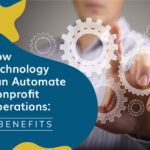Nonprofit Marketing: How Technologies Will Change the Future

Artificial intelligence (AI) has become mainstream in a variety of sectors, including the nonprofit space. Technologies like AI have dramatically altered the way nonprofit professionals at tech-savvy organizations work, and they have the potential to become a staple in the fundraising process.
While AI and other modern nonprofit technologies have great potential, their effectiveness relies on the guidance of knowledgeable professionals. If using these new technologies effectively, nonprofit professionals can speed up their ability to build relationships with supporters, analyze donor data, and create sustainable fundraising plans.
To help nonprofits understand the tools available to them and how they can be incorporated into their digital strategies, this guide will explore three uses of modern nonprofit technology.
Donor Analytics Tools
Nonprofits need to know who their donors are, what gift amounts to request, and when and how to request those gifts. Technology can facilitate the data collection process, theoretically providing nonprofits with all the information they need to answer these questions about their supporters. More recent advances in nonprofit technology can help nonprofits organize that data into a useful format and make sense of it.
AI technology leverages machine-learning capabilities to help nonprofits analyze their donors and make data-driven marketing decisions. This is especially useful for enterprise-level nonprofits managing thousands of donor relationships.
Here are a few ways this type of AI can be used to analyze donors:
- Address donors based on predicated giving level. Nonprofits have limited resources and often focus the bulk of their fundraising efforts on a handful of major donors. With AI, nonprofits can automate this process, allowing them to reach out with personalized giving requests to thousands of donors. While a nonprofit’s major gift officers should still be in charge of crafting those personal relationships, AI can manage the rest of a nonprofit’s donors. This ensures donation requests remain within reason of each donor’s capacity to give while steadily increasing their value.
- Measure affinity in real-time. AI tools are able to take an omnichannel approach to donor analysis. This means they are able to analyze all of a donor’s interactions with a nonprofit across multiple channels and how those interactions build off of their past engagement. This allows AI tools to help nonprofit professionals determine supporters’ relationships with their organizations more accurately.
- Time donation requests. When nonprofits make a donation request can be equally as important as how much they ask for. AI can analyze data related to affinity and capacity, allowing it to suggest when in a supporter’s donor journey they are most likely to be receptive to a donation request.
To ensure AI provides accurate insights, nonprofits should prioritize improving their donor data management. The more specific and thorough a nonprofit’s data is, the better the recommendations an AI tool will be able to make.
NPOInfo’s guide to nonprofit data hygiene advises organizations to audit their data and implement standardization processes. Technology can also help with the maintenance process. For example, many organizations use deduplication tools that are able to analyze donor profiles, images, and other uploaded information for repeated files. When duplicate data is detected, the program alerts users and asks how they would prefer to resolve the issue—merging files, removing one, or keeping both.
Content Creation Assistance
Recently, strides have been made in AI’s ability to help create written content. Strong written content can be essential for keeping donors engaged, whether it showcases a nonprofit’s expertise in their field, commitment to their cause, or ability to relate to supporters.
However, nonprofits should avoid using AI alone to generate their content. While AI tools like ChatGPT are able to replicate more human writing styles, they still possess various tells that readers can pick up on. While advances are being made to prevent this problem, AI chatbots have been known to invent statistics, court cases, research studies, and other information that can be fact-checked.
Of course, AI can still be useful in creating written content when used strategically. Here are a few use cases for AI chatbots:
- Create outlines. To speed up the idea generation process, writers can enter their topic and content format to receive an initial outline. For example, a writer might ask an AI tool to outline an article about five reasons why donating is beneficial for the supporter’s health. The AI would then produce an outline, and the writer may decide that three of the reasons suggested would be useful. They would then flesh out the outline and think of two more reasons based on their own experiences.
- Generate topic ideas. Chatbot AIs are helpful for producing topic ideas for blog articles, presentations, videos, and other long-form content. For instance, an environmental nonprofit could utilize a Chatbot to generate 30 blog ideas for the upcoming month. These ideas could include topics related to the significance of reducing carbon emissions, tips for living a more sustainable lifestyle, and ways for the average individual to contribute to environmental protection. Then, they might take the best 15 ideas across these topics to plan their content. While this may seem like a large number of topic ideas requested in comparison to the number used, forcing AI to generate more content and be more creative can increase the variety of unique ideas.
- Summarize content. AI can help speed up the research process. While writers should still look over the content they intend to cite themselves, AI can be useful for summarizing written works or pulling out highlights. Simply copy and paste the given text into the AI chatbot and request a summary.
While AI is not a replacement for human writers, it can be useful for organizations creating nonprofit marketing materials at scale. For instance, to save writing time, an organization that maintains an active presence on multiple social media platforms might use AI to write post descriptions for Facebook, Instagram, and YouTube.
Automation
Automation allows nonprofit professionals to streamline their workflows and focus on tasks that require a human touch. For example, a donor management system’s basic automation tools might help a nonprofit automate its donation tracking. Nonprofit professionals could then use this information to estimate how much revenue they earn in a month and make a fundraising budget. Then, their bookkeeping automation tools can track their spending.
Most nonprofit technologies have at least some degree of automation. To implement a more advanced AI system that can analyze databases and make recommendations, nonprofits will need to partner with a consultant.
DNL OmniMedia’s guide to nonprofit technology consultants outlines the basic steps for how to partner with a nonprofit consulting firm. Specifically, they recommend not only researching consultants based on initial fit but long-term support. Nonprofits that build long-term working relationships with one consultant can rely on them whenever they have a technical problem or need to implement a new system.
Technology is continually evolving, and nonprofit professionals looking to the future can leverage these tools to improve their operations now. Nonprofits should explore AI tools, research their best practices, and consider how they can be used to further their goals. While many AI platforms are still developing, their power already has the ability to transform nonprofit operations for the better.


